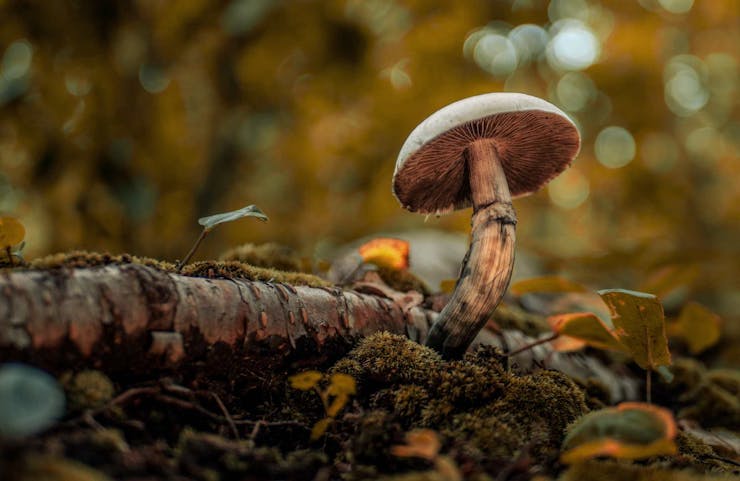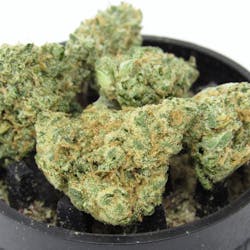When the first rains of fall begin to descend and mornings are soaked in dew, magic begins emerging in the Pacific Northwest—magic mushrooms, to be exact. The perfect combination of humidity, hours of sunlight, wet weather, and warmth conjures psychedelic fungi forth from wood chips, mulch, riverbeds, and decomposing logs.
For many mycophiles, psychonauts, and avid foragers, the start of shroom season is the highlight of the year. Late September and October will find foragers all over the country, and especially in places like Washington and Oregon, venturing into urban parks, wetlands, and forests, armed with warm coats, deep pockets, and even magnifying glasses to identify psychoactive species like Liberty Caps (Psilocybe semilanceata) and Wavy Caps (Psilocybe cyanescens).
Foraging for shrooms—magic or otherwise—can be a fun way to get acquainted with fungi, and amass your own stash of hand-harvested goodies.
“Mushrooms are what opened the door to foraging at large for me,” said Marissa Smith, managing editor at Nisonco. “Foraging often fills me with a sense of joy and wonder—some of my favorite moments alone in the woods have been spent marveling over life’s third kingdom.”
What are magic mushrooms?
Magic mushrooms are fungi with psychedelic properties. There are more than 180 known species of psychedelic shrooms. At last count, 117 of these were members of the Psilocybe genus, most of which contain the psychoactive substances psilocybin, psilocin, and baeocystin.
Shrooms are prized for their ability to induce a hallucinogenic trip that usually lasts anywhere from four to six hours, though microdoses don’t last as long and large doses can last longer. Those who journey with shrooms often describe it as a profound, life-changing experience characterized by kaleidoscopic visions, intense colors, increased appreciation of music, and enhanced sensitivity to touch.
In some cases (usually after high doses), shrooms can also induce mystical states, which can be experienced as a sense of interconnectedness and unity with all things, or the transcendence of time and space. Recent research also indicates that psilocybin mushrooms represent a promising treatment for anxiety, depression, and alcohol addiction.
Where and when do magic mushrooms grow?
Magic mushrooms can be found on every continent except Antarctica. In the United States, psychedelic shrooms can be found scattered across diverse regions. These days, you’re increasingly likely to find mushrooms fruiting in cosmopolitan locales, as well as pristine wildernesses or rural idylls.
Shop highly rated dispensaries near you
Showing you dispensaries near“Urban spore bombing is a thing!” said Justin Townsend, CEO and Head Facilitator of MycoMeditations. “Psychedelic activists have been known to fill innocent-looking water bottles with a liquid containing billions of psilocybin spores and then walk around urban environments spraying these spores so that they can grow right under our noses.”
That being said, distinct shroom species each have their own preferred climatic zone where they thrive. Here’s the lowdown on some of the main regions where you’ll find mushrooms, and when they’re likely to be fruiting in full force.
The Pacific Northwest
The Pacific Northwest has some of the most abundant areas in the US for foraging shrooms. This region is known for its temperate climate due to warm summers, relatively mild winters, and a propensity for rainfall and humidity—which mushrooms just adore.
When the rain and humidity starts to set in at the end of summer, mushrooms begin fruiting. Plentiful psilocybin species flourish in the Pacific Northwest, including
- Cubes or Gold Caps (P. cubensis)
- Liberty Caps (P. semilanceata)
- Wavy Caps (P. cyanescens)
- Blue Ringers (P. stuntzii)
- Bottle Caps (P. baeocystis)
- P. azurescens
- P. allenii
- P. pelliculosa
Foragers will find many of these species fruiting during late September to October after rain or heavy dew, with some making sporadic appearances throughout winter and until early spring.
Mushrooms growing in these zones tend to favor fairly specific conditions. Many can be found growing on substrates, or surfaces, such as wood chips or decomposing wood, or beside riverbeds and forest trails.
Wet wood chips in particular are a big favorite, and have even been called the “fast food of the fungal world.” Since wood chips are often used as mulch in parks and urban landscaping, prospective foragers may not even need to venture into the wilderness to find shrooms—they might be hiding in a local suburban park, unwittingly propagated by municipal landscapers.
“A colleague once told me that he was waiting outside a courthouse for an appointment and found psilocybin mushrooms growing out of the landscaped shrubbery and mulch,” said Townsend. “A few months later he checked out the area again and discovered even more mushrooms growing from the mulch. Next time you see a government-owned landscaping truck full of mulch, it may well contain psilocybin spores.”
The South
Areas in the South, especially parts of Florida and Texas, are also rich in psychedelic mushrooms. These subtropical climates give rise to different species such as Gold Caps (P. cubensis), Panaeolus subbalteatus, and Psilocybe tampanensis.
Unlike their Northwestern cousins, these species tend to favor growing in open grasslands, sandy soil, manure-rich soil or grass, or most appealingly, directly in the dung of herbivorous animals. Cattle pastures of South and East Texas, in particular, can be a hotbed for P. cubensis.
Shrooms in these zones can grow all year round, provided there’s adequate humidity, rain, and an abundance of nutrients available (yes, that’s often dung). In general, however, they tend to be more prolific after a few days of heavy rain.
The Northeast and Midwest
Finally, corridors of the Northeast and Midwest can also yield psychedelic mushrooms. Zones known as “humid continental” provide growing conditions for species such as Psilocybe ovoideocystidiata and Psilocybe caerulipes. Vermont, Ohio, and Pennsylvania are particularly flush with these mushrooms, which thrive in warmish, humid, and damp conditions.
“They are most commonly found in the springtime, especially after a few days of rain,” said Townsend. Both species thrive in wood chips, the woody debris of maple, beech or birch wood, or alongside streams and rivers.
However, the pickings can be slim in other Northeastern states. “In Massachusetts, the psychedelic regulars are Gymnopilus luteus (not very potent, real bitter), Gymnopilus junonius, which is similar, and Panaeolus cinctulus, which is known to be a wildcard in terms of potency,” reflected Smith. “Those shrooms have very similar look-alikes in the region, don’t have the best effects, and ultimately, the juice may not be worth the squeeze. You’re better off cultivating a predictable psychedelic mycelium.”
Tips for shroom foragers
Both Townsend and Smith have some recommendations for those thinking of wandering into the wild (or a local park) in search of psychedelic shrooms.
Go with an experienced forager to accurately identify shrooms
First and foremost is awareness of the risks when it comes to identifying magic mushrooms, which can look indistinguishable from poisonous mushrooms.
“With any kind of mushroom foraging, there are risks as many species are dangerous and look similar to each other to the untrained eye,” said Townsend. “Mushroom poisoning can have serious health consequences leading to hospitalization and even death.”
Smith advises teaming up with an experienced mycologist or local organization if you’re new to foraging. “There’s this beloved saying in foraging: There are old foragers and there are bold foragers, but there are no old and bold foragers,” said Smith. “Enthusiasm is wonderful and necessary for a foraging spirit, but it is no substitute for scientific assurance.”
With over 180 different species of magic mushrooms, no two mushrooms look exactly the same. There’s no quick and easy way to identify a magic mushroom, although many species of the Psilocybe genus do share several distinctive characteristics.
“Psilocybin mushrooms have a thin gelatinous film on the mushroom cap,” explained Townsend. “When bruised, the mushrooms also produce a blue coloring. Rub your finger nail up and down the mushroom stipe [stem], and normally after a short while, a blue color will appear. A spore print can be taken that will normally reveal a brown/purple coloring.”
Spore prints are one of the most reliable ways to identify a mushroom. To make a spore print, cut the stem at the highest point possible without damaging the gills, on the underside of the cap. Lay the mushroom gill side down on a piece of paper, and in six hours or so the spores will imprint onto the paper, capturing the unique signature of the mushroom. Local mycology organizations or online forums will be able to help you determine the genus of the mushroom, and in some cases, the species.
Consider the local environment
Those new to foraging will likely be enthusiastic, But it’s important to forage thoughtfully. “Don’t just tear through the foraging area like a plague of locusts picking every mushroom in sight,” said Townsend. “Think about sustainability.” In other words, take only what you need, and leave some for others.
Also, be aware of the risk of environmental contamination. Consider how the growing system interacts with its environment.
”One colossal caveat I always tell budding foragers is to consider how a system consumes its food and ensure you also want to consume what that organism consumes,” said Smith. “Roadways can introduce all sorts of mild pollutants: car fluids, salt runoff, chemical snow treatments, and asphalt, to name a few.”
Smith also points out that this is a personal decision. “Different foragers will take on different levels of risk—personally, I don’t gather any roadside or lawn foraged items for risk of chemical treatment.”
Be aware of local and federal laws
Finally, foraging for shrooms can carry legal risks. While foraging for wild mushrooms is legal, deliberately foraging for magic mushrooms containing psilocybin is a different matter. At the federal level, psilocybin mushrooms are classified as a Schedule I substance under the Controlled Substances Act, which means it is illegal to cultivate or possess them for personal consumption or distribution.
That being said, the legal landscape is changing, and some states and cities have decriminalized magic mushrooms and other psychedelics.
“The laws surrounding this appear to be a bit ambiguous and open for interpretation, especially with decriminalization in some US states,” commented Townsend. “Certainly, the possession of psilocybin-containing mushrooms is covered under various laws, but what if you just accidentally picked one up and didn’t know it contained psilocybin? Nonetheless, the safest bet is to assume that foraging for psilocybin containing mushrooms in any state is illegal.”





